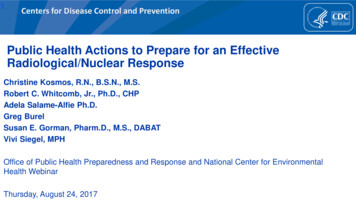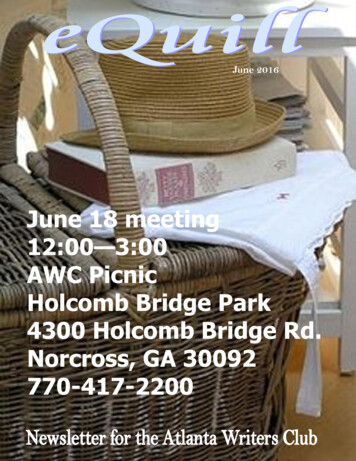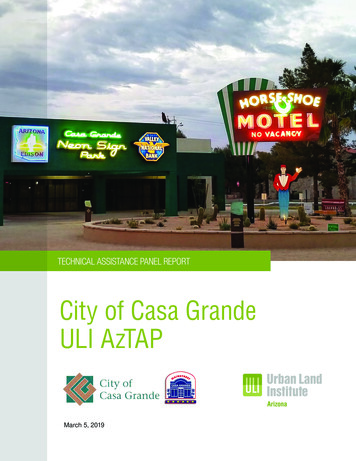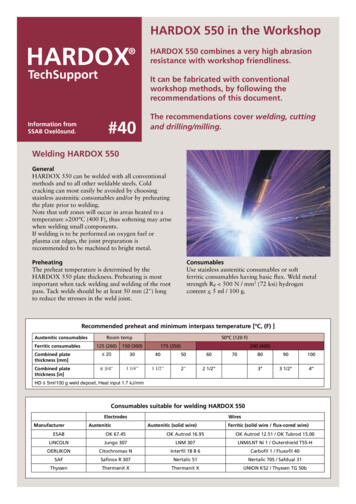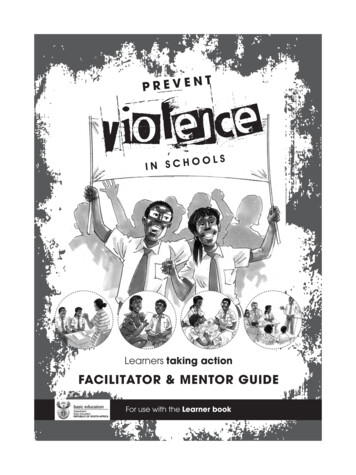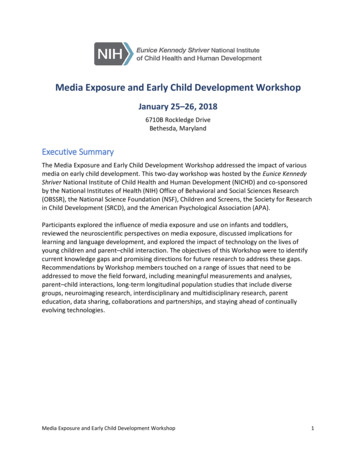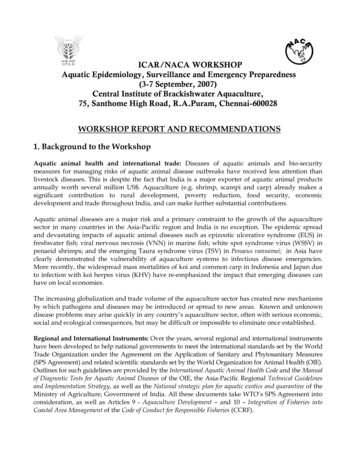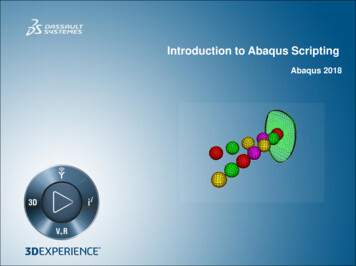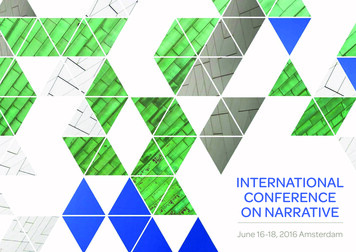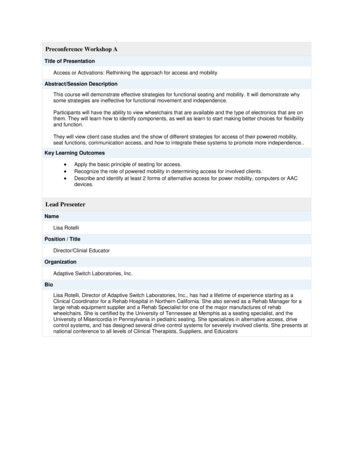
Transcription
Preconference Workshop ATitle of PresentationAccess or Activations: Rethinking the approach for access and mobilityAbstract/Session DescriptionThis course will demonstrate effective strategies for functional seating and mobility. It will demonstrate whysome strategies are ineffective for functional movement and independence.Participants will have the ability to view wheelchairs that are available and the type of electronics that are onthem. They will learn how to identify components, as well as learn to start making better choices for flexibilityand function.They will view client case studies and the show of different strategies for access of their powered mobility,seat functions, communication access, and how to integrate these systems to promote more independence.Key Learning Outcomes Apply the basic principle of seating for access.Recognize the role of powered mobility in determining access for involved clients.Describe and identify at least 2 forms of alternative access for power mobility, computers or AACdevices.Lead PresenterNameLisa RotelliPosition / TitleDirector/Clinial EducatorOrganizationAdaptive Switch Laboratories, Inc.BioLisa Rotelli, Director of Adaptive Switch Laboratories, Inc., has had a lifetime of experience starting as aClinical Coordinator for a Rehab Hospital in Northern California. She also served as a Rehab Manager for alarge rehab equipment supplier and a Rehab Specialist for one of the major manufactures of rehabwheelchairs. She is certified by the University of Tennessee at Memphis as a seating specialist, and theUniversity of Misericordia in Pennsylvania in pediatric seating. She specializes in alternative access, drivecontrol systems, and has designed several drive control systems for severely involved clients. She presents atnational conference to all levels of Clinical Therapists, Suppliers, and Educators
Preconference Workshop BTitle of PresentationApps & AT Across the Curriculum-Supporting Diverse Learners with Google & iOSAbstract/Session DescriptionBuild a Bridge to Learning- AT to Engage&Include Diverse Learners on All Devices Across Curricula,Supporting UDL! Many schools are now BYOD (Bring Your Own Device) (and some are "Going Google" withChromebooks & Google Apps for Education. How do you support diverse learners on all devices, using free &low cost (High Quality) Apps & AT solutions? Join us for this hands-on informative workshop focusing onensuring success for all learners using the tools, features & apps available in Apple’s App Store/Devices &Google’s Chrome Web Store. Support for literacy (Dyslexia/ LD), math, executive function, accessibleworksheets/textbooks, as well as support for our learners who are blind/ low vision and those with physical/motor challenges.Key Learning Outcomes Identify and explore a minimum of 15 iOS (Apple-iPad/ iPhone) apps and accessibility features tosupport students who struggle with literacy, math, executive function and access to curriculum, anddiscuss realistic implementation methods for classwork and homework.Identify and explore a minimum of 10 Chrome apps & extensions to support students who strugglewith literacy, math, executive function and access to curriculum, and discuss realistic implementationmethods for classwork and homework.Identify and explore a minimum of ten free assistive technology tools (accessibility features, software,apps, built-in tools, web resources) to support access to literacy, math, executive function andcurriculum, and discuss realistic implementation methods. Identify and explore technologies thatsupport learning in a UDL environment and provide access to AEM (Accessible EducationalMaterials) including digital textbooks and worksheets.Lead PresenterNameDiana PetschauerPosition / TitleM.Ed., ATP, Consultant, Assistive Technology ProfessionalOrganizationAssistive Technology for Education LLCBioDiana Petschauer, M.Ed., ATP is a RESNA certified Assistive Technology Professional/ Consultant & founderof AT for Education, ATforED.com, and Access4Employment.com Diana has over 20 years of experience inSpecial Education & Assistive Technology, PreK-12, post-secondary & adult services. She presents nationally& internationally including at conferences such as FETC, ATCNE, Closing the Gap, CSUN, ATIA & ARATA.Diana is a faculty trainer for the Center on Technology and Disability (ctdinstitute.org) as well as ATinNH atthe UNH Institute on Disability. Diana manages her multi-disciplinary team of consultants who travel dailythroughout New England to provide AT & AAC evaluations, training, professional development workshops &webinars.
Keynote PresentationTitle of PresentationThe Past as Prologue: Pathways to the FutureAbstract/Session DescriptionOver the past fifty years, numerous milestones document societal, educational, and cultural change. In thisprovocative keynote, Dr. Edyburn will examine selected historical trends and issues that have set the stage forunderstanding scenarios about the future of learning and work.Key Learning Outcomes Understanding of key societal, educational, and disability milestones over the past 50 yearsLead PresenterNameDave EdyburnPosition / TitleProfessor and Associate Dean for ResearchOrganizationUniversity of Central FloridaBioDave L. Edyburn, Ph.D., is a Professor and Associate Dean for Research at the University of Central Florida.Dr. Edyburn’s research and teaching interests focus on the use of technology to enhance teaching, learning,and performance. He has authored over 175 articles and book chapters on the use of technology in specialeducation. His work represents a variety of contributions to theory, research, and practice. Professionally, hehas held national offices in the American Education Research Association, the Council for ExceptionalChildren, and the International Society of Technology in Education. He is a frequent national workshoppresenter.
Presentation #201Title of PresentationAssessing Assistive Tech Options for Large Print and Braille ReadersAbstract/Session DescriptionAssistive technology options for people who visually impaired or blind are ever increasing. Determining the bestoption for a particular individual in a specific setting, with specific tasks can be overwhelming. However, askingthe right questions, tools can be matched that provide increased independence and optimum access toinformation for educational or workplace success. In this interactive session, we will present multiple scenariosin which individuals who are blind or visually impaired need access to print or electronic materials, and workingtogether, discuss challenges and solutions. We will we will review the various options available for braille andlarge-print access and the benefits of specific solutions.Key Learning Outcomes Name three approaches to video magnification for people with low vision.Name at least three considerations in choosing a video magnifier for a person with low vision.State at least three benefits of electronic braille alone or in addition to speech output for educational,employment, or personal use.Lead PresenterNameRenee ClarkPosition / TitleWestern Regional ManagerOrganizationBAUM USABioRenee Clark has been professionally involved in the field of assistive technology for people who are visuallyimpaired or blind for the past 30 years, with a strong commitment to matching the best tool to the individual tomaximize educational or employment success.
Presentation #202Title of PresentationHow to Obtain Assistive Technology as a Client of Vocational RehabilitationAbstract/Session DescriptionOur session will provide information on what Assistive Technology devices and services that can be provided by theState’s Vocational Rehabilitation (VR) Program. It will also explain what to expect during the VR process, the differenttype of assistive technology that may be available to the VR program, and what to do if VR denies their request for AT.Key Learning Outcomes services available through the VR programhow a client can obtain assistive technology through VRtypes of assistive technology that may be available to a VR clientwhat to do if VR denies your request for assistive technologyLead PresenterNameJohn GutierrezPosition / TitleClient Assistance Program Senior Staff AdvocateOrganizationArizona Center for Disability LawBioJohn has been a staff member of the Arizona Center for Disability Law for approximately 28 years. John has been theCoordinator of the Client Assistance Program for 22 years. John is also a member of the Statewide Rehabilitation Council(SRC). Besides assisting clients to receive services through Vocational Rehabilitation, John provides numerous trainingsthroughout the state on disability issues and is an active leader in disability rights.Presenter #2NameLinda FischerPosition / TitleStaff AdvocateOrganizationArizona Center for Disability LawBioLinda Fischer has been an advocate at the Arizona Center for Disability Law for 23 years. Linda works in the ClientAssistance Program (CAP), where she assists applicants and clients who have a problem or a disagreement with theArizona Rehabilitation Services Administration’s Vocational Rehabilitation or Independent Living Rehabilitation Servicesprograms. She also works in the Protection and Advocacy for Beneficiaries of Social Security program (PABSS) andassists individuals who receive SSI or SSDI who are experiencing a barrier to reaching their employment goal. Prior to
working at the Center, Linda worked at the Medicare Advocacy Project in St. Paul, MN and at Western Wisconsin LegalServices.Presentation #203Title of Presentation60 Tips for AT SuccessAbstract/Session DescriptionIn this session participants will be taken through different top ten lists for successful implementation of AT across variousPreK to 12 environments and tasks. The session will guide participants through AT ideas across curriculum and instructionareas. This fast paced session will cover at least 60 tips, so be ready for a ton of useful implementation ideas at a fast past.No worries about getting it all down, we will share them digitally as well. Participants will learn about specific tools acrossreading, writing, math, evaluation, documentation, etc. Be prepared for some fast paced fun.Key Learning Outcomes Identify three resources that can be implemented immediately in their AT practice.Identify five resources they want to learn more about to assist their AT practice.Identify a means of accessing resources and sharing with colleagues during and after the conference.Lead PresenterNameMatthew PressPosition / TitleAssistive Technology SpecialistOrganizationPeoria Unified School DistrictBioMatthew Press is an occupational therapist and assistive technology practitioner. He has practiced in the field of occupationaltherapy since 1999 and has focused in assistive technology since 2002, earning his ATP credentials along the way. Matthewregularly presents at state and national conferences. He has taught courses in assistive technology at Adventist University,Northern Arizona University, AT Still University, and the University of Florida. He currently works in the Peoria Unified SchoolDistrict as a full time member of the Assistive Technology team. Matthew also runs the graduate certificate in AT throughNAU.Presenter #2NameMike AlbertPosition / TitleAssistive Technology SpecialistOrganizationPeoria Unified School DistrictBioI have been married for 18 years, and we have 3 children and 3 dogs. I am originally from Ohio, but have been in AZ for 30years. I graduated from Grand Canyon University with a Bachelors degree in Psychology and received my Masters of Science
degree in Occupational Therapy from The Arizona School of Health Sciences (now AT Still University). I started working inPUSD 16 years ago as an Occupational Therapist, and have been working in the area of assistive technology for the past 9years. I currently serve on the PUSD Assistive Technology Team full time. I am passionate about incorporating technologyinto the classroom to help struggling students succeed in ways they never have before.Presentation #204Title of PresentationApps and Evidence-Based Practice: Defining and Evaluating Apps for Clinical UseAbstract/Session DescriptionThis session will focus on introducing a variety of rubrics available to evaluate iPad applications for evidence-basedspeech-language therapy. In addition to defining criteria for developer credentials, software design, and research base,example reviews of apps achieving the highest developmental standards will be conducted.Key Learning Outcomes Discuss the key application features evaluated by the majority of current software application rubrics.Improve decision making on selecting apps for clinical practice.Utilize a rubric in order to evaluate software applications in terms of research based strategies, andappropriateness for quality clinical intervention.Lead PresenterNameMai Ling ChanPosition / TitleCEOOrganizationYappGuruBioMai Ling received her Master of Science in Communication Disorders from Arizona State University and is a SpeechLanguage Pathologist in the State of Arizona. In addition to her role as CEO and co-founder of YappGuru.com, she is anauthor of Exceptional M.O.B.I.L.E, a certification course providing qualitative steps for students and they're iPad techteam to achieve confidence and competence. She shares knowledge from over 10 years working with children inschools, clinics, and home therapy, in addition to extensive experience with adults and geriatrics in acute, sub-acute,rehabilitation, assisted/independent living and memory care communities.
Presentation #205Title of PresentationHelping Students with Disabilities Gain Access to Complex TextAbstract/Session DescriptionStruggling students often face challenges in achieving grade level standards. As a result, significant attentionwill be needed to provide strategies and tools to help students access and engage in the complex texts theywill encounter. The purpose of this session is to introduce tools and strategies that can be used to helpstudents with disabilities gain access to complex texts in grades 4-12.Key Learning Outcomes Describe why students must access and engage with complex texts.Demonstrate how to measure text complexity.Evaluate the suitability of various technology tools that can be used to alter the cognitive difficulty oftext.Lead PresenterNameDave EdyburnPosition / TitleProfessor and Associate Dean for ResearchOrganizationUniversity of Central FloridaEmailedyburn@uwm.eduBioDave L. Edyburn, Ph.D., is a Professor and Associate Dean for Research at the University of Central Florida.Dr. Edyburn’s research and teaching interests focus on the use of technology to enhance teaching, learning,and performance. He has authored over 175 articles and book chapters on the use of technology in specialeducation. His work represents a variety of contributions to theory, research, and practice. Professionally, hehas held national offices in the American Education Research Association, the Council for ExceptionalChildren, and the International Society of Technology in Education. He is a frequent national workshoppresenter.
Exhibitor Spotlight Presentation #206Organization NameArizona Low VisionTitle of PresentationIntroducing the MoJo digital monocularSession DescriptionBriggs Cunningham will be providing a live demonstration of the new MoJo.Key Learning OutcomesLearning Outcome #1Learning Outcome #2A new digital aid that provides practical mobile accessibilityfor those with low vision.Auto focus now available in a digitalmonocular.Lead PresenterNameBriggs CunninghamPosition / TitleOwnerOrganizationArizona Low VisionBioBriggs Cunningham has been working with the visually impaired community for over 10 years in the field oftechnology.
Exhibitor Spotlight Presentation #207Organization NameAbility CenterTitle of PresentationMobility Transportation SolutionsSession DescriptionThe goal of this presentation is to provide an overall review of many of the automotive transportation solutionsavailable to people with a mobility challenge or to caregivers who need assistance to help transport someonewith a disability. It will also be helpful to individuals recommending automotive mobility equipment and serviceslike OT's, PT's and other health professionals. This presentation is designed to help you understand whatsolutions are available and where to get more information. In addition, it will also give an overview of NMEDA,the National Mobility Equipment Dealer Association which regulates our industry to ensure we are providingsafe and reliable solutions; not just any solution.Key Learning OutcomesLearning Outcome #1Learning Outcome #2Understand and identify the unique process involvedin researching, evaluating, selecting and purchasingautomotive mobility solutions.Identify and learn how to establish a solid andpositive working relationship with your localMobility Equipment DealerLead PresenterNameMonique McGivneyPosition / TitleMarketing Director / NMEDA Board MemberOrganizationAbility CenterBioMonique McGivney is a marketing professional and has dedicated her knowledge and passion to the mobilityindustry for over a decade. After working in the Semiconductor industry for seven years she got the opportunityto be a part of the marketing team at VMI (Vantage Mobility International) who makes wheelchair accessiblevans. She fell in love with the innovation, consumers and the industry and has been a part of it ever since 2005.For two years, she has been with Ability Center, a mobility equipment dealer with 13 locations in CA, AZ, NVand OR. Her role with Ability Center is to ensure the highest brand awareness and educate each communityabout the solutions her stores sell, service and install.In 2017, Monique was voted into the NMEDA (National Mobility Equipment Dealer Association) Board ofDirectorsShe has given this presentation at the California OT and Nevada OT conference.
Presentation #301Title of PresentationLet’s Get Visual: Supporting Students with AutismAbstract/Session DescriptionFrom the moment someone with autism wakes up, to the moment they go to bed, & all minutes in-between,there are numerous opportunities to use many different visual strategies to improve their lives. Visuals, videomodeling, social stories, and more have been found to be successful when working with people with autism.We will address visuals to support instruction, behavior, social skills, independence, communication and more!There is so much to create and so little time to produce all the visuals needed. We will review benefits ofvisuals and many sites that offer pre-made free visual supports and free/low-cost sites to create your ownvisuals. There will be many different examples of visual supports to use throughout a student’s day.Key Learning Outcomes Participants will be able to identify a minimum of 3 different free websites where they can locate premade visuals to utilize to enhance the education of students with autism or intellectual disabilities.Participants will be able to identify a minimum of 3 ways that visuals can help with managingbehaviors of students with autism or intellectual disabilitiesParticipants will be able to identify a minimum of 3 ways that visuals can enhance academicinstruction of students with autism and intellectual disabilitiesLead PresenterNameMo ButiPosition / TitleOwner/AdvocateOrganizationAiepA: Advocate and Instructional Expert for People with AutismBioWith over 26 years of experience, Mo is a practiced professional in the field of special education providingservices and support to those with disabilities and their families. She served as Director of ProgramDevelopment for Neumann Family Services. Prior to Neumann, she directed autism programs and services forover 6,000 students as Manager of Autism and Intellectual Disabilities at Chicago Public Schools. Mo’sadditional experience also includes special education teacher, autism itinerant and special educationadministrator. Mo Buti possesses a M.Ed-BD, M.Ed-ADMIN, QIDP certification, Director of Special Educationdegree/certificate from Illinois and her Type 75 Administrator certification. Mo is a dynamic, internationalspeaker.
Presentation #302Title of PresentationTechnology that Identifies Strengths and Supports Teens & Young Adults with Intellectual DisabilitiesAbstract/Session DescriptionOver the next decade, between a ½ million and 1 million children with autism alone will turn 21 and 86% - 94%will be unemployed or underemployed. Include other intellectual disabilities and the numbers swellexponentially. Sadly, far too often, students leave school completely unprepared for the demands of the realworld: No hope, no future, especially when parents are no longer around to supervise. Increasingly,corporations, organizations and agencies are discovering the benefits of creating neurodiverse employmentopportunities. Until now career plans have been inadequate. Finally advanced technology is available toaccurately identify career strengths, abilities and interests and using AI, support individuals at work andbeyond.Key Learning Outcomes Examine the background of existing and growing problem of employment for teens and adults withIDs and its impact upon individuals, families, communities and country.Explain the qualities of strength based Person Centered Planning (PCP).Explore tech based career tool and AI based assistive technology to be integrated into the fabric ofthe classroom, school, home and community of individuals with ID.Lead PresenterNameSteve KeismanPosition / TitleVP Education, Transition and Neurodiverse Employment SpecialistOrganizationIdentiforBioSteve brings a unique, granular, perspective focusing most of his 33-year career with the NYC Department ofEducation helping students with disabilities transition from school to careers and college. Credited for creatingand providing expertise to best practice programs, partnerships and school restructure initiatives, he hasmasters' degree in SPED and an Education Administration. Steve is VP of Education for Identifor, the world’sfirst career assessment tool that uses computer games to develop relevant career plan for individuals withintellectual disabilities and AI-based, 24/7 Companion, to help support them with a wide-range of lifemanagement needs. Steve consults internationally on topics related to neurodiverse employment.
Presentation #303Title of PresentationSuccessful Transition to College: AT, Accommodations and AdvocacyAbstract/Session DescriptionTransition from high school to college is a significant & critical time in a student's life and educational career.This engaging session will inform participants of process, strategies, assistive technology & resources to helpensure that the transition is a successful one! Many students are not aware of the various accommodationsprovided in college & how to access them. Learn about the different assistive technology & supportiveaccommodation options for students in high school & college. Free & low-cost/ high quality AT options versuspaid AT options will be explored. Self-advocacy skills, communication with professors &instructors, meeting withcounselors, confidentiality, laws, documentation, when to start, what to ask, and more!Key Learning Outcomes Identify and Discuss a Minimum of Seven Accommodations that are available to college studentsregistered with disability services.Discuss the difference between high school and college laws that support students with disabilities inaccessing the educational environment.Explore, utilize and identify a minimum of ten assistive technology options to support students withdisabilities in the college setting, including support for online learning classes.Discuss the difference regarding the parent role versus student role in college and identify strategiesfor self – advocacy while applying for accommodations and using them.Lead PresenterNameDiana PetschauerPosition / TitleM.Ed., ATP, Consultant, Assistive Technology ProfessionalOrganizationAssistive Technology for Education LLCBioDiana Petschauer, M.Ed., ATP is a RESNA certified Assistive Technology Professional/ Consultant & founder ofAT for Education, ATforED.com, and Access4Employment.com Diana has over 20 years of experience inSpecial Education & Assistive Technology, PreK-12, post-secondary & adult services. She presents nationally &internationally including at conferences such as FETC, ATCNE, Closing the Gap, CSUN, ATIA & ARATA. Dianais a faculty trainer for the Center on Technology and Disability (ctdinstitute.org) as well as ATinNH at the UNHInstitute on Disability. Diana manages her multi-disciplinary team of consultants who travel daily throughoutNew England to provide AT & AAC evaluations, training, professional development workshops & webinars.
Presentation #304Title of PresentationAAC, SLPs, & ABA: Using LAMP to Make it WorkAbstract/Session DescriptionSpeech language pathologist’s goals for teaching communication and the BCBA's goals often seem at odds.Both disciplines are seeking to teach communicative behavior. An ABA therapist’s focus is typically shapinglanguage into a behavior but it isn’t that simple. Treating language as if it’s a behavior ignores the many levelsof language and communication. For an individual to generate whatever he wants to say, the SGD needs to beword based. The goal of the LAMP approach is to give non-verbal individuals the ability to independently andspontaneously communicate whatever they want to say. Videos showing a combined ABA & LAMP approachwill be demonstrated. success with some becoming very communicative and some demonstrating increasedverbaKey Learning Outcomes Demonstrate an introductory understanding of verbal behavior as a response category using AACdevicesDescribe strategies for developing and adapting ABA curriculum for children with ASD using AACdevices and LAMP (Language Acquisition through Motor Planning) strategiesDescribe strategies for effective collaboration between a speech language pathologist and a boardcertified behavior analyst working with children with ASDLead PresenterNameJeremy LegaspiPosition / TitleSpeech Language PathologistOrganizationPRCBioJeremy earned his Bachelor’s Degree in Speech and Hearing Science at Arizona State University in 2003. Hecompleted his Master’s Degree in Clinical Speech-Language Pathology at Northern Arizona University in 2005,and his Graduate Certificate in Assistive Technology in 2013. Prior to joining PRC in November of 2014,Jeremy was assistant director at FDH in Gilbert, AZ. Jeremy holds the Certificate of Clinical Competence inSpeech-Language Pathology from the American Speech-Language-Hearing Association (ASHA), a statelicense in Speech-Language Pathology from the State of Arizona, is a member of the Arizona SpeechLanguage-Hearing Association (ArSHA), and is a member of ASHA’s Special Interest Division 12 (AACDivision).Presenter #2NameLydia MacKay
Position / TitleSpeech Language Pathologist/ Board Certified Behavior AnalystOrganizationACCELBioLydia MacKay is a Speech-Language Pathologist who has worked with individuals with a wide variety ofcommunication needs for over 20 years. Her experience includes learners from birth to 22 with AutismSpectrum, Developmental Delays, Speech-Language Impairments, Visual Impairments, and MultipleDisabilities. She has specialized in Augmentative Communication, Social Communication, and AssistiveTechnology for over 18 years. Lydia obtained her Board Certification in Behavior Analysis in 2003, and herArizona license in Behavior Analysis in 2012. She is passionate about teaming with families and professionalsto help learners gain independence with communication and language skills at school, home, and in thecommunity.Presenter #3NameKassi RollinPosition / TitleSpeech Language PathologistOrganizationACCELBioKassi Rollins is a nationally certified Speech-Language Pathologist through the American Speech-Languageand Hearing Association (ASHA). In addition, she is licensed by the State of Arizona as a practicing SpeechLanguage Pathologist. She received both her Bachelors and Masters degree in Speech-Language Pathologyfrom the University of Utah. She enjoys the outdoors, spending time with family, and has several hobbiesincluding reading, quilting and knitting. Kassi loves working with children and helping them to bettercommunicate with their families and friends.
Presentation #305Title of PresentationMulti- Functional Low Vision Devices: Beyond Desktop CCTV'sAbstract/Session DescriptionFocusing on Blind and Low Vision Assistive Technology, this session will discuss the latest and greatest inwearable technology. We will help participant identify the differences between a large selection of videomagnification devices from a variety of manufacturers (including VFO, Freedom Scientific, Optelec brand andEnhanced Vision) and show the differences in OCR, optical character reading devices and portable all in oneMulti-Functional equipment for on the go easy to setup and use. These advances in technology have takenBlind and Low Vision Assistive Technology to a new level and we are excited to share all of this with you!Key Learning Outcomes Understand wearable technology and its multi-functional featuresKnow the differences between each of the devices.Lead PresenterNameElizabeth EvansPosition / TitleTechnology ConsultantOrganizationViewfinder Low Vision Resource CenterBioElizabeth Evans is a licensed optician. She has worked exclusively in low vision for the past 11 years and iscurrently the Manager of outside sales for video magnification with Viewfinder Low Vision Resource Center,which offers the largest selection of low vision products in the Southwest.
Exhibitor Spotlight Presentation #306Title of PresentationPresenters: Find out how to share your message with the world and earn passive in
University of Misericordia in Pennsylvania in pediatric seating. She specializes in alternative access, drive . Matthew Press is an occupational therapist and assistive technology practitioner. He has practiced in the field of occupational therapy since 1999 and has focused in assistive technology since 2002, earning his ATP credentials along .


